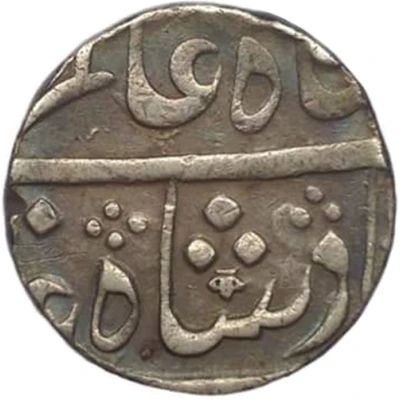


© Mohit Kapoor
1 Rupee - Shah Alam II Ankushi; Transitional mint - Poona
| Silver | 11.18 g | 20.5 mm |
| Issuer | Bombay Presidency (British India) |
|---|---|
| Type | Standard circulation coin |
| Years | 1228-1244 (1818-1833) |
| Calendar | India - Fasli era |
| Value | 1 Rupee |
| Currency | Rupee (1672-1835) |
| Composition | Silver |
| Weight | 11.18 g |
| Diameter | 20.5 mm |
| Shape | Round |
| Demonetized | Yes |
| Updated | 2024-10-05 |
| Numista | N#71146 |
|---|---|
| Rarity index | 88% |
Reverse
Legend in Urdu: Zarb Muhiabad Poota (sic-Poona)/ Sanah Jalus Maimanat Manus (date in Devnagari)१२३८
Lettering: १२३८
Translation: Struck at Muhiabad Poona in FE 1238 during tranquil prosperous reign
Edge
Plain
Comment
- Poona mint (Transitional mint), East India Company issue- Listed in KM under India Independent kingdoms - Maratha Confederacy which is wrong based on facts mentioned below
- The third Anglo - Maratha war (known as the Pindari war) ended in 1818 AD., with the defeat of the Marathas at the hands of the British East India Company forces led by Governor General Hastings. The Peshwas were defeated at the Battle of Khadki (then spelt Kirkee) on 5 November 1817 near Pune and the city was seized by the British. It was placed under the administration of the Bombay Presidency. These coins dated 1820-44, were issued by the EIC after the war ended in 1818. They were issued in the name of the Mughal Emperor so they would be accepted by the local people.
- Fasli Era has a 12 month calendar from July to June. Adding 590 to Fasli year = Gregorian calendar (AD)
Fasli which means (harvest) is derived from the Arabic term for division, which in India was applied to the groupings of the seasons. Fasli Calendar is a chronological system introduced by the Mughal Emperor Akbar
- Shah Ali Gauhar was another name for Shah Alam II
- Mint mark, 'Ankush' (Elephant goad - a hook like instrument used by trainers to control the elephant), see image. This mint mark is also found on Maratha issue rupees.
Interesting fact
One interesting fact about this coin is that it was minted during a time of transition for the Bombay Presidency, which was a province of British India. The minting of this coin, specifically at the Poona mint, was a result of the shifting of power from the Ankushi mint to the Poona mint during this time period. This coin serves as a unique representation of the historical changes that took place during this era.



